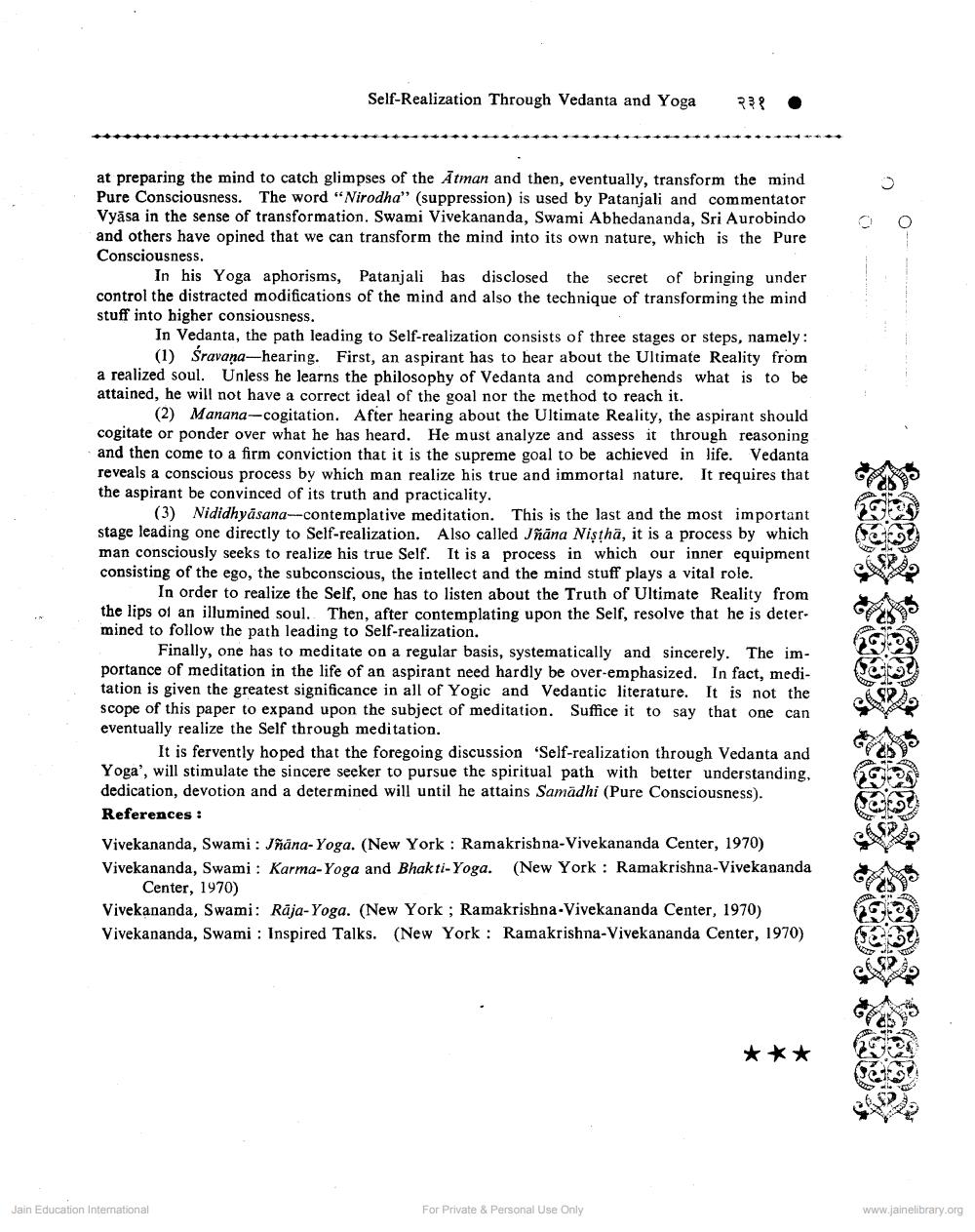Book Title: Self Relization through Vedant and Yoga Author(s): Kiyoshi Kuromiya Publisher: Z_Pushkarmuni_Abhinandan_Granth_012012.pdf View full book textPage 4
________________ Self-Realization Through Vedanta and Yoga 738 at preparing the mind to catch glimpses of the Atman and then, eventually, transform the mind Pure Consciousness. The word "Nirodha" (suppression) is used by Patanjali and commentator Vyasa in the sense of transformation. Swami Vivekananda, Swami Abhedananda, Sri Aurobindo and others have opined that we can transform the mind into its own nature, which is the Pure Consciousness. In his Yoga aphorisms, Patanjali bas disclosed the secret of bringing under control the distracted modifications of the mind and also the technique of transforming the mind stuff into higher consiousness. In Vedanta, the path leading to Self-realization consists of three stages or steps, namely: (1) Sravana-hearing. First, an aspirant has to hear about the Ultimate Reality from a realized soul. Unless he learns the philosophy of Vedanta and comprehends what is to be attained, he will not have a correct ideal of the goal nor the method to reach it. (2) Manana-cogitation. After hearing about the Ultimate Reality, the aspirant should cogitate or ponder over what he has heard. He must analyze and assess it through reasoning and then come to a firm conviction that it is the supreme goal to be achieved in life. Vedanta reveals a conscious process by which man realize his true and immortal nature. It requires that the aspirant be convinced of its truth and practicality. (3) Nididhyasana--contemplative meditation. This is the last and the most important stage leading one directly to Self-realization. Also called Jnana Nistha, it is a process by which man consciously seeks to realize his true Self. It is a process in which our inner equipment consisting of the ego, the subconscious, the intellect and the mind stuff plays a vital role. In order to realize the Self, one has to listen about the Truth of Ultimate Reality from the lips of an illumined soul. Then, after contemplating upon the Self, resolve that he is determined to follow the path leading to Self-realization Finally, one has to meditate on a regular basis, systematically and sincerely. The importance of meditation in the life of an aspirant need hardly be over-emphasized. In fact, meditation is given the greatest significance in all of Yogic and Vedantic literature. It is not the scope of this paper to expand upon the subject of meditation. Suffice it to say that one can eventually realize the Self through meditation. It is fervently hoped that the foregoing discussion 'Self-realization through Vedanta and Yoga', will stimulate the sincere seeker to pursue the spiritual path with better understanding, dedication, devotion and a determined will until he attains Samadhi (Pure Consciousness). References : Vivekananda, Swami: Inana-Yoga. (New York : Ramakrishna-Vivekananda Center, 1970) Vivekananda, Swami: Karma-Yoga and Bhakti-Yoga. (New York : Ramakrishna-Vivekananda Center, 1970) Vivekananda, Swami: Raja-Yoga. (New York ; Ramakrishna-Vivekananda Center, 1970) Vivekananda, Swami : Inspired Talks. (New York: Ramakrishna-Vivekananda Center, 1970) VO Too som DVD *** Jain Education International For Private & Personal Use Only www.jainelibrary.orgPage Navigation
1 2 3 4
